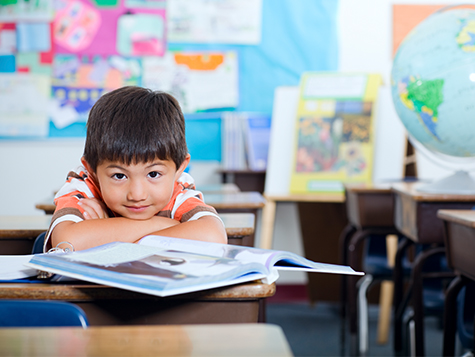 As a spinoff of Read Across America Day, the University of Alabama at Birmingham is partnering with Glen Iris Elementary for Read and Move Across America Day to encourage literacy and activities focused around critical thinking and movement.
As a spinoff of Read Across America Day, the University of Alabama at Birmingham is partnering with Glen Iris Elementary for Read and Move Across America Day to encourage literacy and activities focused around critical thinking and movement.
“We are excited to partner with an area school to share books and activities that we believe will impact student learning,” said Tonya Perry, Ph.D., professor in the UAB School of Education and director of Interdisciplinary Outreach and Engagement. “The combination of both reading and kinesthetic activities will increase student engagement and promote retention of important skills that can be transformational to students as they develop their own independent approaches to interacting with texts.”
Faculty, students and staff from the UAB School of Education will spend the day at Glen Iris Elementary reading to classrooms and leading activities related to the book. They will read the following titles:
- “A Bear Sat on My Porch” (Yolen, 2018)
- “Can I Be Your Dog?” (Cummings, 2018)
- “Hey Wall: A Story of Art and Community” (Verde, 2018)
- “The Bad Seed” (John, 2017)
- “28 Days: Moments in Black History that Changed the World” (Smith, 2015)
- “Let the Children March” (Clark-Robinson, 2018)
- “The Little Red Fort” (Maier, 2018)
- “The Day You Begin” (Woodson, 2018)
- “What Can a Citizen Do?” (Eggers, 2018)
- “The Good Egg” (John, 2018)
- “The Word Collector” (Reynolds, 2018)
All of these books are recently published, high-quality, diverse picture books dealing with a range of topics from scary new beginnings to how art can transform and unify a community. Each book is accompanied by activities related to the books, which incorporate movement through dance, drama and action storytelling where children are actively participating and joining in with the reading of the text.
Jennifer Summerlin, Ph.D., assistant professor in the UAB Department of Curriculum Instruction, hand-picked the books based on the opportunity for a rich literacy experience. According to Summerlin, literacy is an important aspect of our everyday lives. Most of the books were chosen based on titles created by award-winning authors and illustrators, such as books identified as notables having received one or more literary awards.
“These texts have been proved to impact thinking critically about the world and to ask extension questions that further connect students to their learning,” Summerlin said. “No matter our age, gender or background, being able to read has become a necessity in our lives. We are constantly reading, from traffic signs to the way we communicate through messaging systems like email, social media and text messages. It is important that we start educating our children at an early age to help with their reading comprehension skills.”
Summerlin provided three tips for parents to help engage their children in literacy and reading:
- Read aloud to your child every day no matter the age of the child. Sharing a good read-aloud moment is one of the easiest ways to create a true love for reading. This reading passion is what will sustain your child as he or she learns to read.
- Pick picture books. Picture books are made to be read to children by adults rather than to be used to teach children to read. There are many picture book authors who address mature content, providing powerful opportunities for critical conversations with your child.
- Don’t forget poems and nonfiction. Many times, we choose stories; but poetry and nonfiction are also crowd pleasers. Just as most adults do, children love to learn new things — this makes nonfiction books quite appealing. Even very young children can read the pictures to learn new things about animals, people, places and things. Just as nonfiction does, poetry appeals to a child’s love of language, inviting word play and vocabulary building.
Sandra Sims, Ph.D., associate professor of kinesiology in the UAB Department of Human Studies, worked with Summerlin to provide physical movement activities to accompany the books. Movement in the classroom helps children develop their motor skills and enhances learning.
“While literacy is important, we also see the value in developing children through physical activity,” Sims said. “We encourage children to get up and move while they are learning in a classroom setting. The movement helps them retain their focus and expend energy, while learning the skills needed to develop both mentally and physically.”
Sims suggests that parents and educators find ways to incorporate movement into daily tasks at home and in the classroom. Movement needs to occur every 50 minutes after being sedentary. Some ideas include:
- Move to the beat. Turn the music on, or play a music video. Dancing skills are not required. Just stand up and move for the length of the song.
- Move to answer. Teachers ask students questions and provide locations in the classroom as options for answers. The students will answer by moving to a spot in the room, such as the front, back or sides of the classroom.
- Integrate to motivate. Add movement to academic extension activities such as writing in the air with a ribbon stick, reciting numbers or facts while tossing a yarn ball, juggling a scarf or jumping rope.
- Walk and talk. Discussions in the classroom are not sit-down time. Instead of turn and talk, have everyone walk and talk in the room.
- Commercial stretch break. During every commercial, someone call out a stretch, a yoga pose or an exercise. Complete it during the commercial.
There is a joy in movement and reading. Teachers and parents need to find activities that are fun, free and easy for children to do while incorporating these aspects of learning. “In fact, we all need to move and read more,” Perry said.